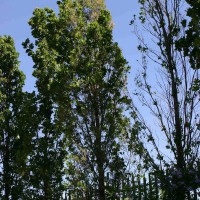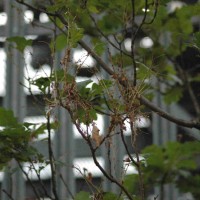
Oak Processionary Moth - Thaumetopoea processionea
Expand and collapse the sections below by clicking on the title or + / - icons.
Short description of Thaumetopoea processionea, Oak Processionary Moth
Adult wingspan 30-40 mm; Larvae can be distinguished by the long white hairs arising from reddish-orange warts along the length of the body and older larvae have a dark stripe along the middle of the back and a whitish line along each side. 100 to 200 eggs (overwintering stage) laid in rows and covered by a grey scale. The name "processionary moth" relates to the larval behaviour of forming long lines or ‘processions’ during foraging. Larvae also aggregate in communal nests made of white silk webbing under a branch or on the trunk. The scientific name is derived from the toxin thaumetopoein contained within the irritant hairs.
Impact summary: Thaumetopoea processionea, Oak Processionary Moth
Major defoliator of oaks in Europe. Also found on hornbeam, hazel, beech, sweet chestnut and birch. Larvae are also a risk to human health as they are covered in irritant hairs that contain a toxin. Contact or inhalation of these hairs can result in severe skin irritation and allergic reactions.
Habitat summary: Thaumetopoea processionea, Oak Processionary Moth
On twigs and small branches of oak canopies. Larvae feed in groups and when not feeding, congregate in communal nests made of white silk webbing under a branch or on the trunk.
Overview table
| Environment | Terrestrial |
|---|---|
| Species status | Non-Native |
| Native range | Middle Europe, Southwestern Europe, Southeastern Europe |
| Functional type | Herbivore |
| Status in England | Unknown |
| Status in Scotland | |
| Status in Wales | |
| Location of first record | Mawnan Smith |
| Date of first record | 1983 |
Origin
Central and southern Europe, where it is widely distributed, but its range has been expanding northwards, probably in response to climate change.
First Record
Larvae first appeared in GB in summer 2006 and has begun to breed in oak trees in several locations in the west and south west of London. It is likely that the spread of this species is limited by climatic conditions (particularly cold winters) in GB.
Pathway and Method
Probably through the importation and planting in GB of living trees infested with over-wintering eggs or possibly by the immigration of an adult female that subsequently laid eggs. All oak trees imported into GB from other EU countries now require a "plant passport".
Species Status
Established in northern France and the Netherlands, and reported from southern Sweden. Resident in the Channel Islands. Sporadic records from southern counties of England since 1983 of immigrants (all male). Larvae have been found in parts of London since 2006.
Dispersal Mechanisms
Male moths are strong fliers and can cross the channel but females are unlikely to disperse long across distance naturally. The long distance dispersal, between countries, is likely to occur through movement of live oak trees for planting. The overwintering egg masses are highly cryptic, and attached to trees, which are usually transported in the winter when dormant. The larvae typically follow one another head-to-tail in long processions. Adult moths fly at night from July until early September and are attracted to light. Although the females are weak fliers, it is unclear how far they are capable of dispersing naturally.
Reproduction
100-200 eggs per adult are laid in July and August, on twigs and small branches in the canopy, and overwinter as eggs. Larvae hatch the following year, from April to June, and feed in groups.
Known Predators/Herbivores
Parasitoids and some generalist predators such as some species of birds, beetles and small mammals.
Resistant Stages
None known.
Habitat Occupied in GB
Urban trees, amenity and other oak woodlands.
Males occasionally appear as vagrants on the south coast of England; females are weak fliers and do not naturally cross the Channel. Recently, colonies of larvae have been found in parts of London. All sightings must be reported, either to the appropriate local council in London or, in all other areas, to Forest Research (contact details available via the links at the end of this factsheet).
Environmental Impact
A major defoliator of oaks (Quercus spp.) in Europe although the moth does not kill the host tree it can reduce vigour and in Germany is associated with oak decline. Hornbeam, hazel, beech, sweet chestnut and birch are also reported to be attacked when growing next to severely defoliated oaks.
Health and Social Impact
Larvae are a risk to human health as they are covered in minute irritant hairs that contain a toxin. Contact or inhalation of these hairs can result in severe skin irritation, allergic reactions and asthma or other breathing difficulties. Oak processionary moth poses a significant problem because once established it tends to be more abundant on urban trees, along forest edges and in amenity woodlands, where there is a high probability of it coming into contact with people.
Economic Impact
Economic loss of amenity value of oak trees is likely to be significant. The costs of control measures and mitigating human health impacts should also be considered.
Identification
Forest Research General Information (includes contact details for reporting sightings)
Biology, ecology, spread, vectors
Forest Research General Information
Royal Horticultural Society Advice
Management and impact
Forest Research Control Options
Maier, H., Spiegel, W., Kinaciyan, T., Krehan, H., Cabaj, A., Schopf, A. and Honigsmann, H. (2003) The oak processionary caterpillar as the cause of an epidemic airborne disease: survey and analysis. British Journal of Dermatology, 149(5), 990-997.
General
Spotted this species?
Distribution map
View the Distribution map for Oak Processionary Moth, Thaumetopoea processionea from NBN Atlas





